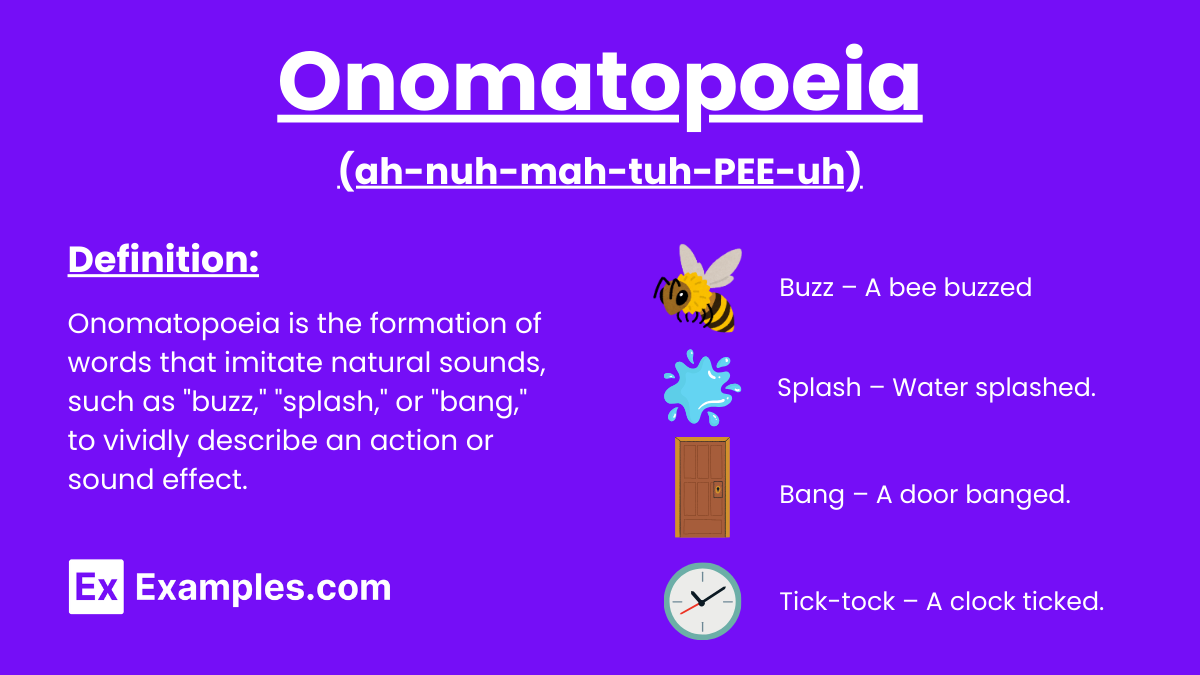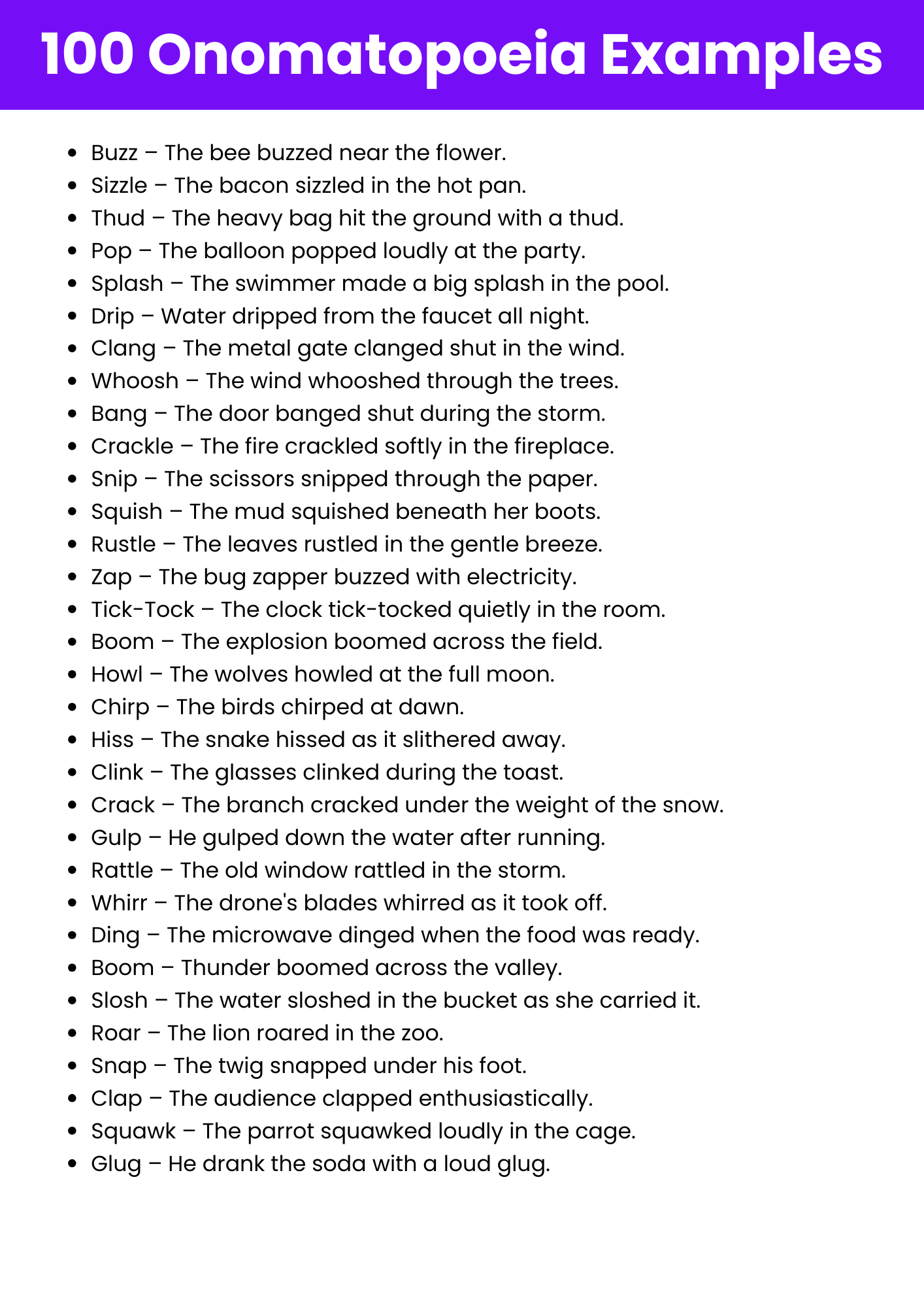Onomatopoeia
What is Onomatopoeia? – Definition
Onomatopoeia is a figure of speech where words are used to imitate sounds. These words mimic the actual sound associated with the object or action they refer to, making descriptions more vivid and expressive.

Generated Onomatopoeia Examples

Download Onomatopoeia Examples
Enhance your understanding with our comprehensive PDF guide.
Download PDFExamples of Onomatopoeia
- Buzz – The bee buzzed around the flowers.
- Whisper – She whispered a secret.
- Crash – The waves crashed against the shore.
- Sizzle – The bacon sizzled in the pan.
- Beep – The car beeped as it reversed.
- Bang – The door banged shut.
- Hiss – The snake hissed quietly.
- Roar – The lion roared loudly.
- Splash – The children splashed in the puddles.
- Tick-Tock – The clock tick-tocked throughout the night.
- Drip – The faucet dripped all night.
- Clang – The bell clanged loudly.
- Buzz – The phone buzzed on the table.
- Click – She clicked her heels together.
- Thud – The book fell with a thud.
- Bang – The door banged open.
- Screech – The brakes screeched loudly.
- Whirr – The fan whirred softly.
- Splash – The kids splashed in the puddles.
- Pop – The balloon popped suddenly.
- Buzz – The mosquito buzzed near my ear.
- Ring – The phone rang continuously.
- Tick-Tock – The clock tick-tocked steadily.
- Clap – The audience clapped enthusiastically.
- Snap – She snapped her fingers to the rhythm.
- Thump – The heavy box thumped on the floor.
- Rustle – The leaves rustled in the wind.
- Bang – The fireworks banged in the sky.
- Splat – The paint splatted onto the canvas.
- Whack – He gave the ball a whack with the bat.
Types of Onomatopoeia
Animal Sounds
Words that mimic the sounds made by animals, often used in storytelling and poetry.
- Baa – The sheep baaed loudly in the barn.
- Neigh – The horse neighed as it galloped away.
- Chirp – Birds chirped at dawn near the river.
- Croak – Frogs croaked near the pond all night.
- Oink – The piglet oinked while running in the mud.
Nature Sounds
Words that imitate sounds found in the natural environment, enhancing vivid descriptions.
- Howl – The wind howled through the mountains.
- Rustle – The leaves rustled in the gentle breeze.
- Gush – Water gushed out of the broken pipe.
- Drip – Raindrops dripped off the roof after the storm.
- Roar – The waterfall roared as it cascaded down.
Mechanical Sounds
Words representing sounds made by machines, tools, or other man-made objects.
- Clink – The glasses clinked during the toast.
- Whirr – The drone’s blades whirred above the field.
- Beep – The alarm beeped continuously in the office.
- Clang – The hammer clanged against the metal plate.
- Tick – The wall clock ticked in the quiet room.
Impact Sounds
Words that mimic noises created when objects hit each other or a surface.
- Thump – The book fell to the ground with a thump.
- Smack – He smacked the table in frustration.
- Bang – The car door slammed shut with a bang.
- Crash – The vase crashed into pieces on the floor.
- Boom – A loud boom echoed after the fireworks.
Liquid Sounds
Words that replicate the sounds of liquids in motion or impact.
- Splash – The diver hit the water with a big splash.
- Glug – He drank the water with a loud glug.
- Drizzle – The rain drizzled lightly on the pavement.
- Gurgle – The stream gurgled as it flowed over rocks.
- Squish – The boots squished through the muddy ground.
Musical Sounds
Words that imitate musical tones or sounds from instruments.
- Ting – The triangle tinged softly in the background.
- Strum – He strummed the guitar lightly under the moonlight.
- Plink – The piano plinked out a cheerful tune.
- Boom – The bass drum boomed loudly during the march.
- Ding – The bell dinged to signal the end of class.
Comic Sounds
Exaggerated sounds often used in humor or comics to depict dramatic actions.
- Pow – He was knocked out with a loud pow!
- Zap – The superhero zapped the villain with a laser beam.
- Whoosh – The rocket took off with a whoosh.
- Kaboom – The explosion went off with a kaboom!
- Bam – He slammed the door shut with a loud bam.
How to Identify/Find Onomatopoeia?
To identify onomatopoeia, look for words that phonetically imitate or resemble the sound they describe. These words often stand out because their pronunciation mimics the actual sound, enhancing the sensory experience of the text.
- Listen for words that replicate natural sounds.
- Identify words that add auditory imagery to the description.
- Check if the word’s sound enhances the meaning or mood.
- Notice if the word creates a vivid sensory experience.
- Look for onomatopoeic words that are integral to the theme or setting.
How to Use Onomatopoeia?
Use onomatopoeia to bring your writing to life by incorporating words that mimic sounds. This technique enhances the reader’s sensory experience, making scenes more immersive and dynamic. Ensure that the sounds you choose are appropriate and add value to the narrative.
- Select sound words that fit the context and atmosphere.
- Use vivid and specific sound words to make your writing more engaging.
- Integrate onomatopoeia seamlessly into your descriptions and dialogues.
- Ensure the sound words enhance the reader’s understanding or emotional response.
- Avoid overusing onomatopoeia to maintain their impact and effectiveness.
Other Onomatopoeia Examples
Onomatopoeia in Daily Life
Daily life is filled with onomatopoeic words that help us convey sounds we hear, making our descriptions more vivid and relatable.
- Tick
- Splash
- Buzz
- Clang
- Honk
Onomatopoeia Examples for Kids
Introduce children to the fun world of onomatopoeia with relatable sound words like “meow” or “bang”.
- Meow
- Woof
- Moo
- Buzz
- Quack
Onomatopoeia Examples for Students
Empower students with onomatopoeia that make learning engaging, such as “clang” in a science experiment or “buzz” in a biology class.
- Clang
- Buzz
- Sizzle
- Crash
- Whirr
Onomatopoeia Examples for Poems
Rich and evocative onomatopoeic words that enhance the beauty and imagery in poetic language.
- Rustle
- Splash
- Clang
- Whirr
- Bang
Onomatopoeia Examples in Movies
Onomatopoeic words used in movies to amplify sound effects and immerse the audience in the scene.
- Whoosh – The superhero’s cape made a whooshing sound as he leaped off the building.
- Bang – The gunshot echoed with a loud bang during the action scene.
- Zap – The villain’s laser weapon zapped with an electric hum.
- Crash – The car crashed into the wall, leaving a trail of destruction.
- Boom – Explosions boomed as the building collapsed.
Onomatopoeia Examples in Literature
Onomatopoeic words in literary works that bring scenes to life and engage readers’ senses.
- Rustle – “The rustle of leaves echoed in the silent forest.” (From a descriptive nature passage)
- Clang – “The clang of the swords rang out as the warriors fought.” (From an epic battle scene)
- Buzz – “The buzz of insects filled the humid jungle.” (From an adventure novel)
- Drip – “Drip, drip, drip – the sound of water leaking from the pipe was maddening.” (From a suspense thriller)
- Howl – “The wolves howled under the pale moonlight.” (From a Gothic novel)
Onomatopoeia Examples in Books
Onomatopoeic words in books that enhance storytelling by mimicking real-world sounds.
- Tick-Tock – “The tick-tock of the old clock kept her awake.” (From a mystery novel)
- Pop – “Pop! The cork flew off the bottle, signaling the celebration.” (From a contemporary fiction novel)
- Thud – “A loud thud startled her as the book fell off the shelf.” (From a suspense novel)
- Splash – “The splash of water as the kids jumped into the lake filled the air with laughter.” (From a children’s book)
- Boom – “A boom in the distance signaled the arrival of a storm.” (From a dystopian novel)
Explore Other Literary Devices
Elevate Your AP English Preparation
Unlock your potential with our comprehensive AP English exam preparation tools designed to help you excel.
- Extensive Question Bank: Access 900+ exam-like questions for both AP English Language and Literature.
- Expertly Crafted: Questions mirror the structure and difficulty of actual AP exams, ensuring relevant practice.
- Detailed Explanations: Understand your mistakes with clear, concise breakdowns of correct and incorrect answers.
- Personalized Learning: Tailor your study sessions with topic-specific tests and adaptive learning tools.
- Comprehensive Coverage: Master all aspects of the AP English curriculum with extensive guides and resources.
Frequently Asked Questions
-
What is an onomatopoeia?
An onomatopoeia is a figure of speech where a word imitates the natural sounds associated with an object or action it refers to, enhancing the sensory experience in writing. -
How does an onomatopoeia differ from a simile?
Unlike similes, which use “like” or “as” to compare two things, onomatopoeias are words that phonetically mimic the sounds they describe, providing a direct auditory representation. -
Why are onomatopoeias important in writing?
Onomatopoeias enrich writing by adding vivid auditory imagery, making descriptions more engaging and helping readers to hear the sounds being described, thus enhancing the immersive experience. -
Can onomatopoeias be extended?
Yes, while onomatopoeias are typically single words, they can be part of longer phrases or sentences that create a more detailed auditory scene, enhancing the overall sensory effect. -
How can I effectively create my own onomatopoeias?
To create effective onomatopoeias, focus on the natural sounds associated with the action or object, experiment with different phonetic combinations that mimic those sounds, and ensure they fit seamlessly within the context of your writing.

